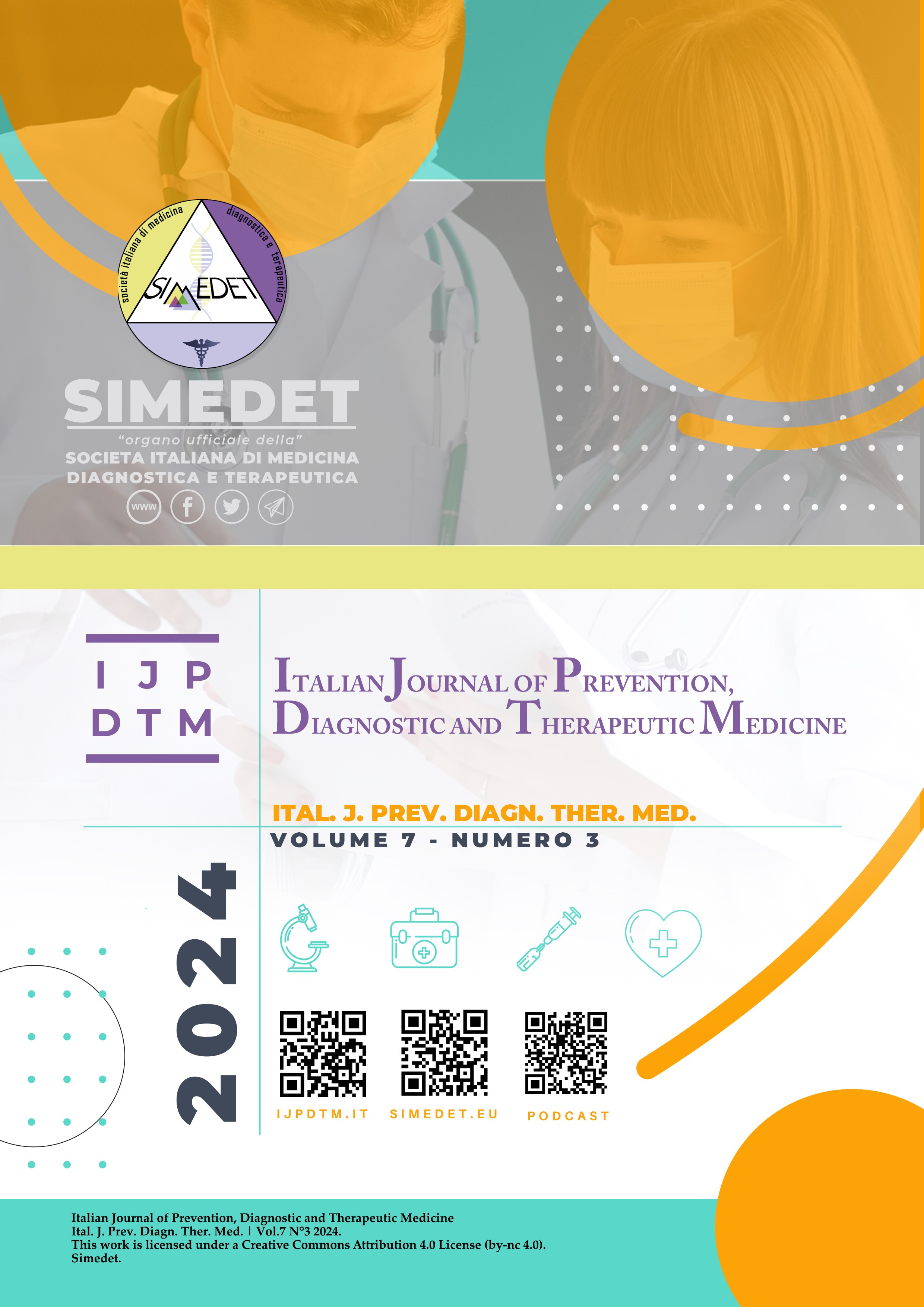Report of neurological manifestations in family members affected by hereditary transthyretin amyloid polyneuropathy
Main Article Content
Abstract
Backgrounds: Transthyretin-related familial amyloid polyneuropathy (TTR-FAP) is an autosomal dominant disorder caused by mutations of the transthyretin (TTR) gene. Clinical symptoms such as polyneuropathy are predominant in patients with the Glu109Gln (p.Glu89Gln) mutation. The aim of this work is to present the neurological manifestations in family members affected by hereditary transthyretin amyloid polyneuropathy.
Materials and methods: We report a Macedonian family (three brothers) from North Macedonia, affected by transthyretin familial amyloid polyneuropathy.
Results: Three brothers with TTR-FAP from North Macedonia were hospitalised at the Clinic of Neurology in Skopje. In addition, there was a positive finding from the genetic analysis, with a present pathogen mutation in the TTP gene, Glu109Gln (p.Glu89Gln). The clinical presentation was with progressive length-dependent sensory-motor polyneuropathy, which started with loss of thermal and pain sensation in the feet and slowly ascends up the limbs with affected musculoskeletal reflexes. This clinical appearance is associated with variable autonomic disturbances. We used the Neuropathy Impairment Score (NIS) to determine the association between the severity of neuropathy and disease stage as well as estimate the rate of neuropathy progression. In all three brothers, an increase in the NIS scale was observed within consecutive measurements.
Conclusions: TTR-FAP is an uncommon illness that can be life-threatening. The illness can manifest in a variety of ways with varying indications and symptoms, so it is critical to increase clinician awareness. Early initiation of anti-amyloid treatment is essential for a better outcome.
Downloads
Article Details

This work is licensed under a Creative Commons Attribution-NonCommercial 4.0 International License.
References
ANDRADE C. (1952). A peculiar form of peripheral neuropathy; familiar atypical generalized amyloidosis with special involvement of the peripheral nerves. Brain : a journal of neurology, 75(3), 408–427. https://doi.org/10.1093/brain/75.3.408
Hawkins, P. N., Ando, Y., Dispenzeri, A., Gonzalez-Duarte, A., Adams, D., & Suhr, O. B. (2015). Evolving landscape in the management of transthyretin amyloidosis. Annals of medicine, 47(8), 625–638. https://doi.org/10.3109/07853890.2015.1068949
Freeman, R., & Barroso, F. (2015). Recent advances in familial amyloid polyneuropathy. Current opinion in neurology, 28(5), 494–499. https://doi.org/10.1097/WCO.0000000000000244
Parman, Y., Adams, D., Obici, L., Galán, L., Guergueltcheva, V., Suhr, O. B., Coelho, T., & European Network for TTR-FAP (ATTReuNET) (2016). Sixty years of transthyretin familial amyloid polyneuropathy (TTR-FAP) in Europe: where are we now? A European network approach to defining the epidemiology and management patterns for TTR-FAP. Current opinion in neurology, 29 Suppl 1(Suppl 1), S3–S13. https://doi.org/10.1097/WCO.0000000000000288
Yamashita, T., Ando, Y., Okamoto, S., Misumi, Y., Hirahara, T., Ueda, M., Obayashi, K., Nakamura, M., Jono, H., Shono, M., Asonuma, K., Inomata, Y., & Uchino, M. (2012). Long-term survival after liver transplantation in patients with familial amyloid polyneuropathy. Neurology, 78(9), 637–643. https://doi.org/10.1212/WNL.0b013e318248df18
Murakami, T., Sango, K., Watabe, K., Niimi, N., Takaku, S., Li, Z., Yamamura, K., & Sunada, Y. (2015). Schwann cells contribute to neurodegeneration in transthyretin amyloidosis. Journal of neurochemistry, 134(1), 66–74. https://doi.org/10.1111/jnc.13068
Erdogan, C., Tekin, S., Unluturk, Z., & Uyguner, Z. O. (2021). Different phenotypes of transthyretin-associated familial amyloid polyneuropathy due to a mutation in p.Glu109Gln in members of the same family. Northern clinics of Istanbul, 8(4), 398–401. https://doi.org/10.14744/nci.2020.98852
Adams D (2001). Hereditary and acquired amyloid neuropathies. Journal of neurology , 248, 647–657. https://doi.org/10.1007/s004150170109.
Adams D. (2013). Recent advances in the treatment of familial amyloid polyneuropathy. Therapeutic advances in neurological disorders, 6(2), 129–139. https://doi.org/10.1177/1756285612470192
Suanprasert, N., Berk, J. L., Benson, M. D., Dyck, P. J., Klein, C. J., Gollob, J. A., Bettencourt, B. R., Karsten, V., & Dyck, P. J. (2014). Retrospective study of a TTR FAP cohort to modify NIS+7 for therapeutic trials. Journal of the neurological sciences, 344(1-2), 121–128. https://doi.org/10.1016/j.jns.2014.06.041
Plante-Bordeneuve V. (2014). Update in the diagnosis and management of transthyretin familial amyloid polyneuropathy. Journal of neurology, 261(6), 1227–1233. https://doi.org/10.1007/s00415-014-7373-0
Maia, L. F., Magalhães, R., Freitas, J., Taipa, R., Pires, M. M., Osório, H., Dias, D., Pessegueiro, H., Correia, M., & Coelho, T. (2015). CNS involvement in V30M transthyretin amyloidosis: clinical, neuropathological and biochemical findings. Journal of neurology, neurosurgery, and psychiatry, 86(2), 159–167. https://doi.org/10.1136/jnnp-2014-308107
Mariani, L. L., Lozeron, P., Théaudin, M., Mincheva, Z., Signate, A., Ducot, B., Algalarrondo, V., Denier, C., Adam, C., Nicolas, G., Samuel, D., Slama, M. S., Lacroix, C., Misrahi, M., Adams, D., & French Familial Amyloid Polyneuropathies Network (CORNAMYL) Study Group (2015). Genotype-phenotype correlation and course of transthyretin familial amyloid polyneuropathies in France. Annals of neurology, 78(6), 901–916. https://doi.org/10.1002/ana.24519
Barbov I, Kalcev G. (2023). Hereditary transthyretin amyloidosis (hATTR) with polyneuropathy in North Macedonia: current evidence and experiences [Abstract]. Journal of the Peripheral Nervous System, 28(Supplement4), S6, https://doi:10.1111/jns.12585

